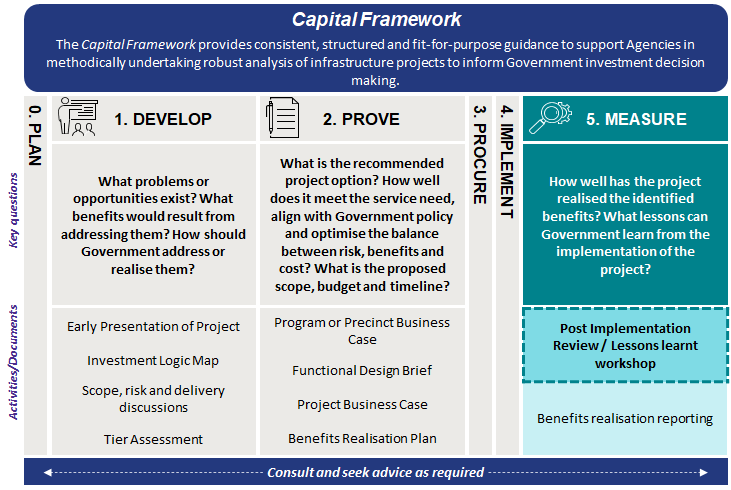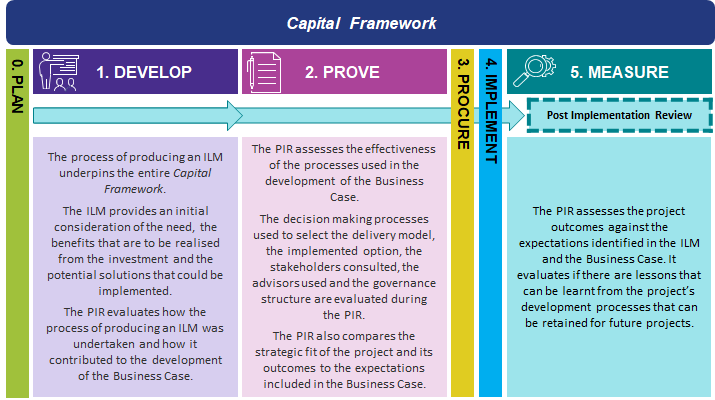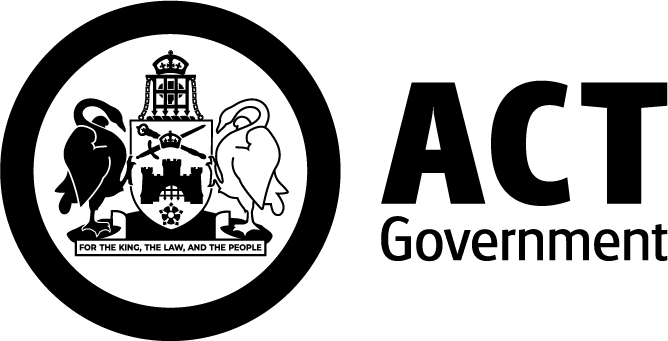Supporting Templates
The Post Implementation Review (PIR) process is a useful means to capture lessons learnt from projects to improve future planning, delivery and risk mitigation pathways and processes. PIRs are not intended to find fault in the implementation of projects, but should focus on understanding and learning from experience.
The PIR process sits within Stage 5 – Measure of the Capital Framework and is designed to help answer the key questions of this stage and, in particular, the latter question of this stage:
How well has the project realised the identified benefits?
What lessons can Government learn from the implementation of the project?
The PIR is also a useful way for the Project Team to evaluate if the project’s objectives were met. Benefits realisation reporting may inform this process (see Key outputs for further information).
PIR in the Capital Framework process

Tier requirements
- Tier 1 projects: The Sponsoring Agency must undergo a formal PIR process for the project (as described in Post Implementation Review process section and Evaluation methodology section). For Tier 1 projects, ICA will work with the Agency in obtaining funding for the PIR process. Typically, a cost estimate would be included in the business case.
- Tier 2 projects: The Sponsoring Agency is strongly recommended to undertake a formal PIR process where possible (as described in Post Implementation Review process section and Evaluation methodology section). Sponsoring Agencies are highly likely to obtain valuable insights from Tier 2 project PIRs that are directly relevant and readily applicable to future projects.
Sponsoring Agencies that choose to undertake a PIR for a Tier 2 project can request assistance from ICA for projects that:
- Use a new delivery model
- Use a new financing strategy
- Use an Alliance, Delivery Partner or PPP delivery model
- Are of a significant value or complexity
- Are of particular significance in terms of stakeholder engagement
- Use a new governance model.
The PIR Report template provides guidance on how to develop the PIR Report for Tier 1 and Tier 2 projects
In general, funding for the PIR process will come from the Sponsoring Agency. Where funding is not available within the Sponsoring Agency’s existing budget, the Project Team should consider including the funding amount for the PIR process in the cost estimate within the Business Case. For more information, refer to the Guidelines on Financial Analysis.
In consultation with the Sponsoring Agency, ICA may decide to take the lead in managing a PIR for significant Tier 2 projects (including seeking funding), such as those described in the dot points above.
- Tier 3 projects: The Project Team is recommended to undergo a lessons learnt workshop, with similar projects bundled together. For Tier 3 projects, only sections on this page and Lessons learnt workshop section of this guidance are relevant.
Resourcing for the lessons learnt workshop process should come from the Sponsoring Agency. Where sufficient resourcing is not available within the Sponsoring Agency, ICA can provide assistance to the Project Team to prepare for and facilitate the lessons learnt workshop.
Purpose of the section
The purpose of this section is to support Government in completing a PIR and to:
- Illustrate how the PIR process fits into the Capital Framework
- Describe the principles that guide the undertaking of a PIR
- Explain the processes and steps to perform a PIR and identify the roles required
- Provide an overview of the PIR evaluation methodology and what it measures.
Objectives of a Post Implementation Review
The purpose of a PIR is to facilitate continual improvement in project development and implementation across Government. The PIR evaluates if there are any improvements, successes, or lessons that future Project Teams can learn, or that the Capital Framework can incorporate in its guidance material. The sharing of these lessons is essential for effective organisational learning.
The key objectives of the PIR process are to:
- Assess how well a project has been planned, procured and implemented
- Evaluate outcomes against expectations
- Recognise what lessons can be learnt from the project for the benefit of future project planning and delivery
- Enhance organisational learning about investment development and project planning, procurement, implementation and ongoing management processes.
Key outputs
For Tier 1 projects and some Tier 2 projects, the PIR process and outcomes are documented in a PIR Report that is prepared for consideration by the Expenditure Review Committee of Cabinet (ERC) or responsible Subcommittee of Cabinet. The PIR Report and any attachments are to be treated as Cabinet information once finalised, as the primary audience for the PIR Report is ERC.
A standalone PIR Summary Report must also be prepared. The PIR Summary Report should contain the key findings, successes, improvement opportunities and lessons learnt, but not sensitive or commercial-in-confidence information (e.g. detailed stakeholder commentary).
The PIR Summary Report will be made available by ICA to Agencies, as required, to inform future project development and implementation.
Interdependencies
The scope of the PIR covers the entire Infrastructure Investment Lifecycle and includes each of the stages in the Capital Framework process. The PIR process feeds back into the start of the Infrastructure Investment Lifecycle where lessons learnt can influence the development of future projects.
The PIR will focus on certain activities across the Capital Framework, which are shown in the diagram below.
Interdependencies between the PIR and the Capital Framework

Relationship between the PIR and the Benefits Realisation Plan (BRP)
While the PIR and BRP each serve a different purpose, there is a close relationship between both processes. The purpose of the PIR is to support continual improvement in project development and implementation across Government. The BRP, on the other hand, has a primary purpose to assess whether a project achieves its expected benefits over time, as outlined in the Business Case. The PIR is a one-off assessment for learning and improvement, whereas the BRP is an ongoing assessment for monitoring and correcting the benefits realisation process.
The Sponsoring Agency should ensure that, where it develops both a BRP and undertakes a PIR, these processes complement and integrate with one another. This could occur in the following ways:
- The PIR Advisor who conducts the PIR should use the BRP and any benefits realisation reporting that has been undertaken prior to the development of the PIR to inform the ‘Needs’ and ‘Benefits’ Evaluation Areas, within the ‘Need’ Evaluation Category.
- The Benefits Manager should use the lessons learnt and findings of the PIR with respect to the ‘Needs’ and ‘Benefits’ Evaluation Areas to inform ongoing benefits realisation reporting.
Footnotes:
